We were half-expecting this to happen, really. Visually, the GT-2000 update doesn’t reveal much, given the nature of Asics’ incremental refresh approach. The upper looks more or less the same, fundamentally. Looking at pictures, the midsole design appeared to have undergone a few evolutionary brushstrokes. But it is hard to tell how a shoe will behave until you put them to use.
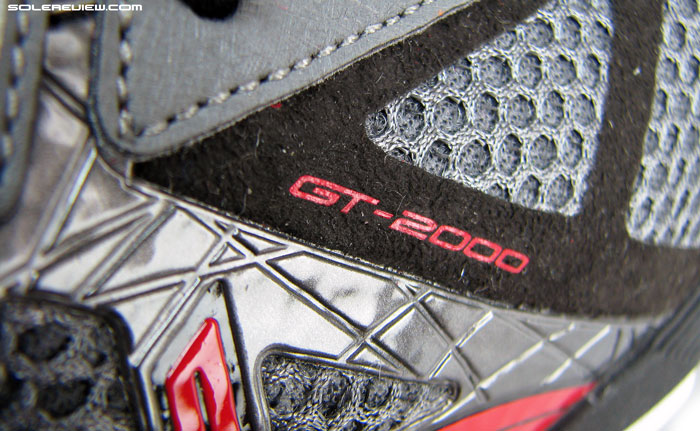
The Kayano 21 became softer, and so did the GT-1000 3. So in the natural order of things, what would follow next?
However, we had an inkling of how the GT-2000 3 would feel like, even before it hit blacktop. You see, we’re done reviewing the GT-1000 3 and Kayano 21 a couple of months ago, and you know what happened to both of them. They became softer to run in compared to their past selves, helped by some tinkering below the upper.
After a few runs in the new GT-2000, it became evident that we assumed correctly. As it turns out, the GT-2000 3’s claim to fame is its new, softer level of cushioning, binding it with the GT-1000 3 and Kayano 21’s repurposed mannerisms. And no, it’s not the lightweight boast splashed on Asics webpages; in fact the new GT-2000 3 is heavier than last year’s GT-2000 2 for the same size. When we first read about the GT-2000’s ‘lightest’ claim, we thought we were wrong, so both shoes were weighed -again. Same result, so this is a marketing fail. Either that, or the factory didn’t get the memo.
The upper sees some changes too, leading to a slight fit difference over the GT-2000 2. Starting today, we’re going to include an infographic which sums up the changes vs. the previous model (whenever applicable) in detail. So don’t miss it – that’s at the bottom of this review, just before the comments section.
The change in cushioning level is a sum of parts, namely the redesign of midsole stacking, foam density (midsole and insole), Gel volume and heel crash pad. The basic construction doesn’t change; two layers of midsole foam (black and white) are stacked together with forefoot and heel Gel pads embedded within. The harder density ‘Duomax’ under the arch side carries over, utilized with the intent of controlling inward foot roll.
Foam densities have been changed on both the midsole layers. The upper portion (black) of the new GT-2000 3’s midsole becomes firmer than GT-2000 2. On the other hand, the lower midsole layer (white) gets an increased serving of squishiness.
One might be inclined to think the firmer black EVA and softer white would counteract each other and deliver zero net gains, but that’s not how this ends.
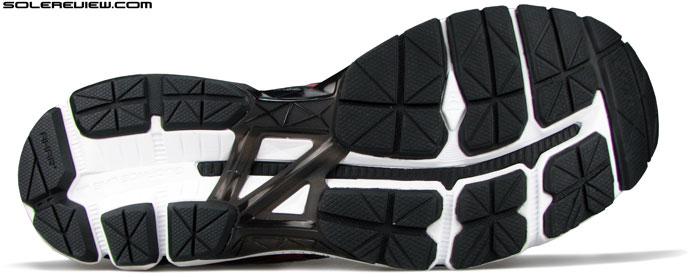
The lower portion of midsole rests on the final contact surface – the outsole. Hence any change in its softness will impact the ride, regardless of how firm the upper layer might be.
A softer white area has a greater influence on the GT’s cushioning, because that part of the midsole is directly connected to the outsole. The GT-2000 3 sole design has multiple pieces of rubber mounted on midsole pods, so a softer base will allow better ’sink-in’ of the outsole.
The split outsole design runs across heel and forefoot, so the ‘pistoning’ effect is felt at all stages of gait cycle – starting from footstrike to transitions, and finally toe-offs.
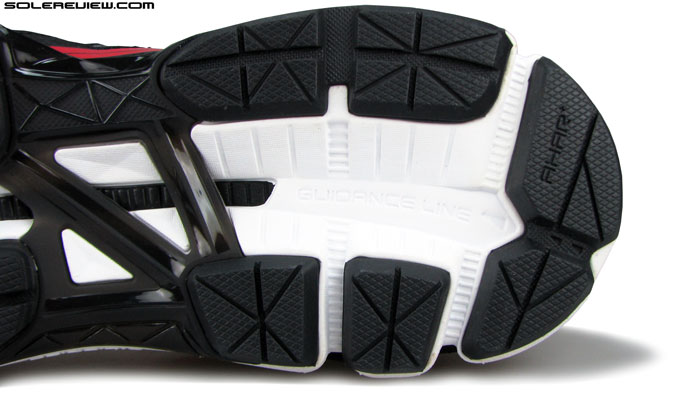
Bigger crash pad, combined with hard rubber pieces mounted on softer foam pods, results in a softer ride.
Keeping in line with outsole design updates on the GT-1000 and Kayano, the heel crash pad is now shaped differently. It is bigger, and now vaguely resembles a half-oval shape instead of the sort-of-triangle design from the year before.
As a result of this change, a deep flex groove cuts across the heel width. This helps splay the heel area much better than before, and hence making the cushioning feel softer upon footstrike.
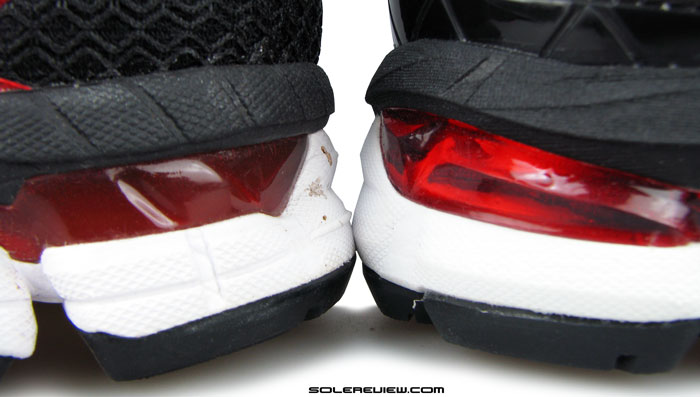
The new GT-2000 3 (right) might appear higher in stack heights than old gen GT-2000 2 (left), but that is simply the raised midsole wall doing its thing.
And while at it, the visible area of Asics heel Gel has become bigger, cranking up lateral softness. A few might notice the GT-2000 3’s heel to sit higher than the previous version, but our read is that the stack heights remain unchanged.
Though the picture above shows otherwise, the cosmetic increase is due to higher midsole walls designed to accommodate the new plastic heel counter on the upper.
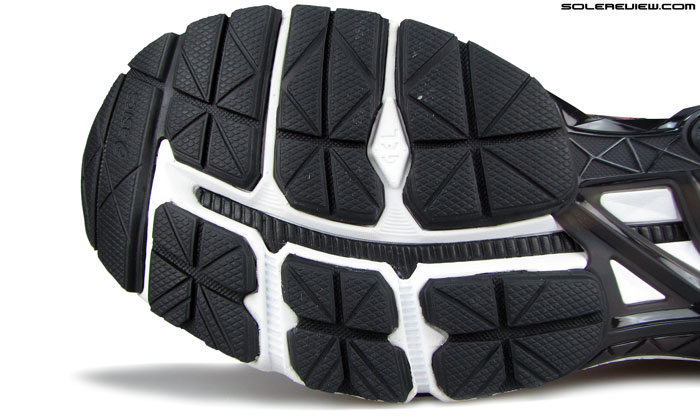
Forefoot outsole geometry looks familiar. Softer blown rubber chunks glued on midsole. But the ‘Guidance line’, the groove which runs along the center, has become wider.
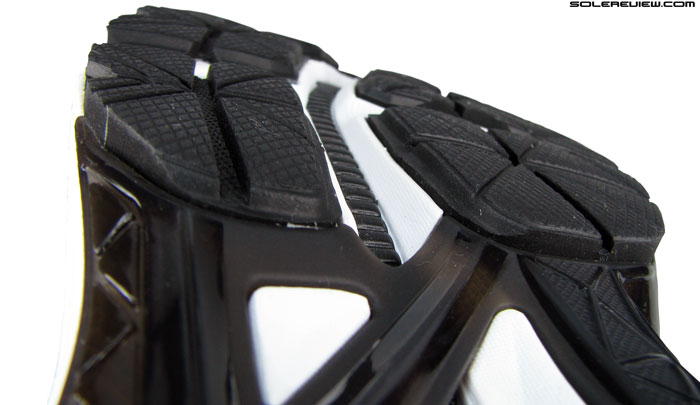
A wider groove allows for better splaying (and of course, transition), and consequently increasing cushioning levels.
Forefoot also comes through as softer, though not to the same extent as heel. Besides the softer midsole base, we also felt an increased splaying action of the ‘Guidance line’ groove. In the GT-2000 3, this is wider than what used to be, hence making the forefoot more conducive for splay.
This can also be seen as Asics’ way of compensating stability loss; a wide guidance line also keeps the foot better centered during transitions.
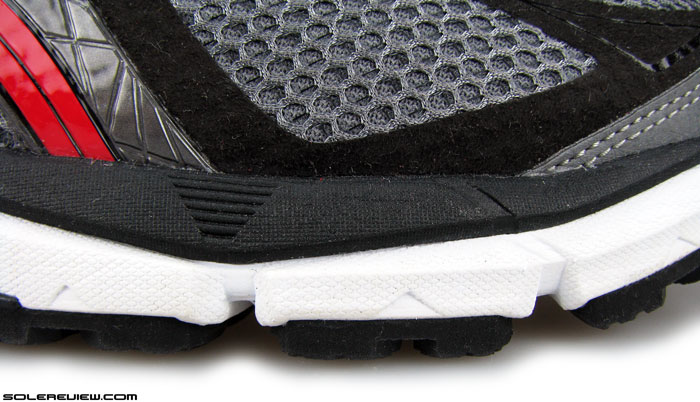
Forefoot becomes stiffer and more work to bend, as the firmer black foam swoops downwards in a ‘V’ shape.
There is decreased flexibility as the firmer black foam extends downwards at a ‘V’ shape just around the flex area. If you found the GT-2000 2 stiff, the new shoe is even more so.
This might be good news or bad. Fast pacers might actually find the stiffness productive for quick transitions, while others might find this to be more work for their feet.
In our pairs (GT-2000 2 & 3), we found the newer insole to be slightly softer than before. Foam used seemed less denser and puffed compared to GT-2000 2, and blankets the already softer midsole with an extra dimension of padding. The strobel (SPEVA55) carries over exactly, no updates on that one.
Once you switch between the current and previous version of GT-2000, the increase in softness is instantly noticeable. More pronounced in rearfoot, where the softer foam, more Gel and crash pad splay play together to deliver cushioning. And one can’t help thinking what cost might this have on stability. The new GT-2000 3 definitely loses some of that stable feeling which was a part of GT-2000 2, as the midsole gets depleted of firmness.
You also have to know that the previously very-firm ‘Duomax’ medial post hasn’t been spared the magic dust of softness; it loses some of its firm feel when compared to GT-2000 2.
This is the general direction in which Asics seems to be headed. The Kayano 21 for example, is supposed to be a motion control/support shoe. But if you run in the new Kayano blindfolded, there is absolutely no way you would have guessed that to be Asics’ premier support shoe. Instead, you’d be given to believe that you were wearing a plusher and softer version of the Nimbus.
While this approach is sure to net Asics a larger population of neutral runners, it has the potential to isolate old time stability loyalists.
If one wanted a firmer and stable ride, the way would be either to downmarket to a GT-1000 3, or pick a hardcore stability shoe like the 2015 Gel Fortify, among many others. The Kayano 21 and GT-2000 3 can barely be classified as stability shoes. At best, they offer some level of motion control, but that’s as far as they go.
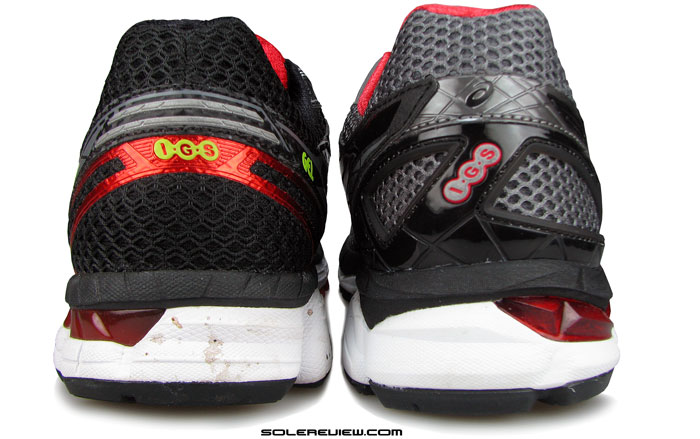
Taking design cues from the latest Kayano, the GT-2000 3 (right) now comes with an external heel counter.
The GT-2000 3 tries to restore some balance by bulking up the heel counter. It now comes with an external, molded heel clip similar to what’s on the new Kayano, replacing the internal stiffener. The black midsole walls rise up slightly to wrap the base, and like we mentioned earlier, makes the heel look thicker.
Does this add stability? A bit of a placebo, we’re afraid. From a functional perspective, the internal counter of GT2K-2 did as good a job.
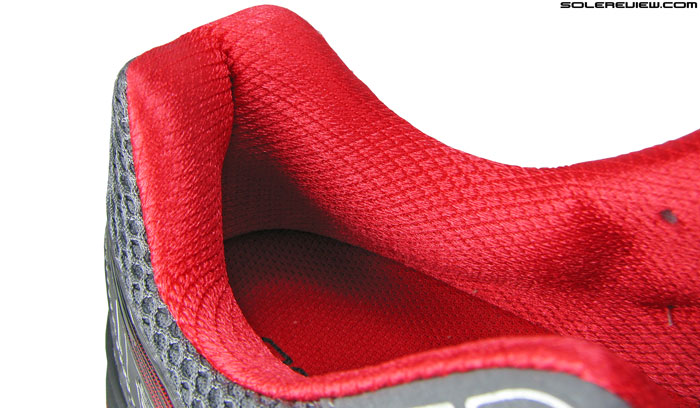
The external heel counter has the foot position move slightly rear-wards, opening up some toebox room. Collar padding is plush and comfy.
However, the plastic clip does impact overall upper fit, and happens to be one of the two upper changes worth of note.
The new external heel construction has a lesser tendency to push the foot forward.The counter sits further rear from the foot compared to the relative closeness of the internal heel stiffener. This helps the foot to sit further out in the rear, hence opening up some room in the front.
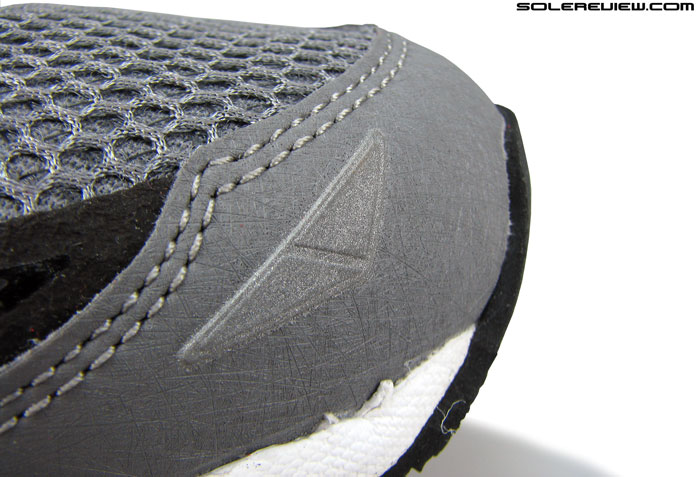
Toe bumper has been raised higher this year. Synthetic leather has a brushed metal texture, and features the only frontal piece of reflectivity.
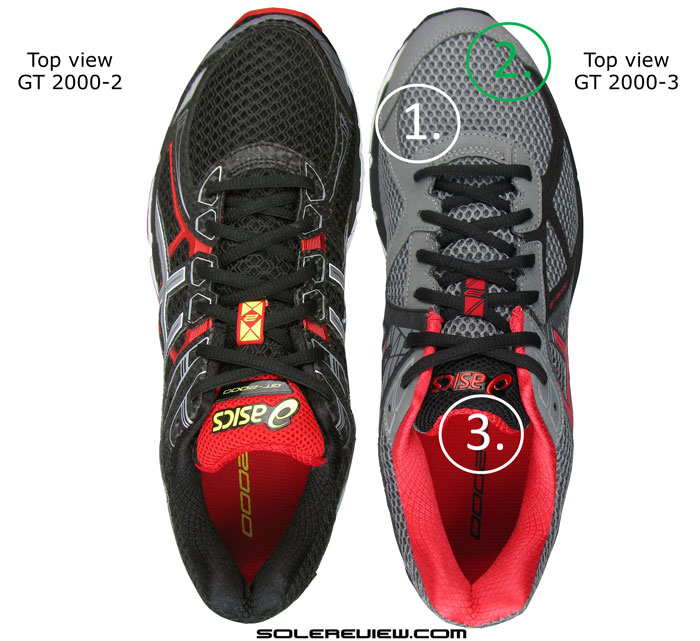
1) Mesh change and change of overlay pattern position. 2) Synthetic leather toe bumper is extended over toe box. 3) Tongue is shorter.
For the same size and width as the previous GT, the refreshed GT-2000 3 comes through as a shoe with slightly more room right at the front. This is despite the redesigned toe bumper, which now extends further over the toe-box.
Speaking of which, forefoot is the second area which sees a minor fit change. The fit is snug in standard D width, similar to how the GT-2000 2 felt. That said, there are a couple of upper design changes which affect forefoot fit.
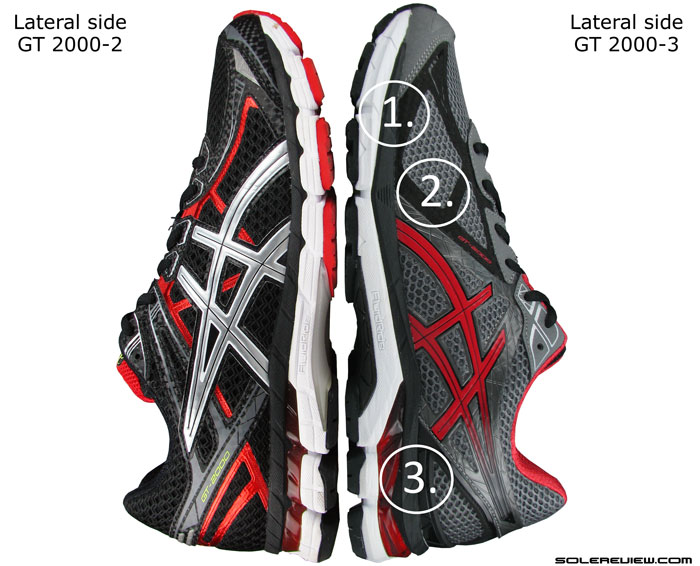
1) Overlay pattern change, opening up some room. 2) Redesigned midsole stacking in forefoot 3) Larger visible Gel unit and higher midsole walls.
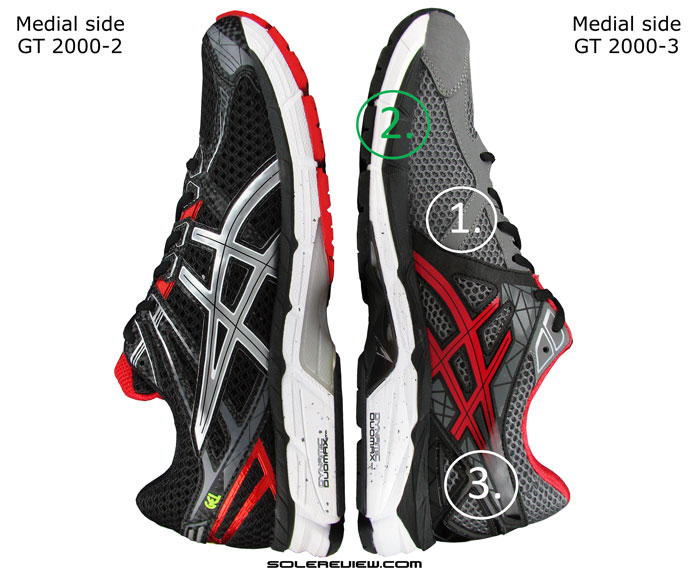
1) Overlay pattern change, opening up some room. 2) Redesigned midsole stacking in forefoot 3) Inclusion of plastic heel counter.
In GT-2000 2, two different overlays – synthetic leather and welded overlay covered the small toe on the lateral (outer) side. This year, that overlay is reduced to a single layer of synthetic nubuck fused over mesh. This eases off some of the top down pressure on the small toe.
The same thing is repeated on the medial (inner) side, where the overlays (which cross over the big toe base) are moved towards the back.
The medial side-only lining seen on the GT2K-2 is still a part of the upper, except that it has large holes in it, most likely for ventilation.
Regardless, the GT-2000 3 still remains a shoe with a snug forefoot, with not much room to splay. Fortunately Asics offers four widths (B, D, 2E and 4E) in a few countries, which affords a desired level of forefoot space.
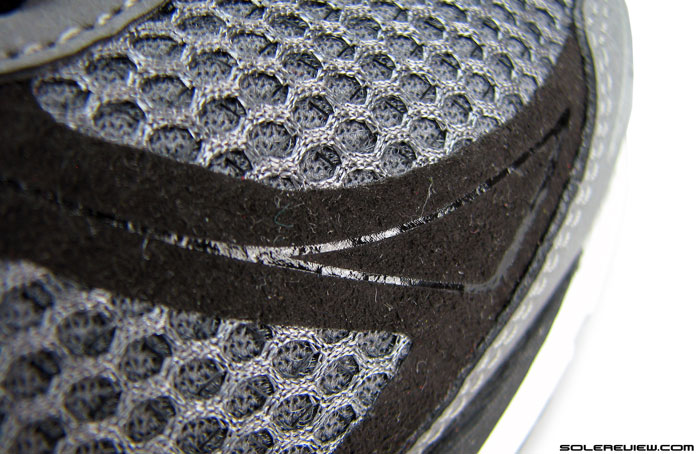
New mesh looks cheaper than what was used on the older GT. Some of the forward overlays have been changed to synthetic Nubuck with print details on them.
Aesthetic and structural core of the upper remains more or the less the same. Mesh with overlays, an ungusseted tongue, standard lacing. Materials are changed, with the mesh now looking thin and unquestionably downmarket. A thinner mesh helps breathability, but the quality doesn’t befit a $120 shoe. Synthetic leather has a brushed metal texture, somewhat similar to Nimbus 16. Reflectivity has been reduced on the heel, and the tongue is a bit shorter than GT-2000 2. Midfoot wrap and arch support was average on the GT-2, and that trait carries over here.
That is pretty much the long and short of the GT-2000 3. And if you were to ask us how it compares with the lower tier GT-1000 3 and premium Kayano 21, that can be easily summed up. The Kayano 21 feels nearly twice as cushioned and plush, but with a much snugger forefoot fit. The GT-1000? Similar fit, but with less pressure over the small toe. The GT-1000 is much firmer to run in, but feels a bit lumpy in places.
(Disclaimer: For this review, solereview bought the shoe at full US retail price.)
Looking to upgrade your old GT-2000 2 to the latest version, but not sure how the 2015 model compares? We can help here. The following infographic is a ready-reckoner for what changes you might expect in the new model vs. old. To make this more fun, we’ve put in a system of percentage match, which calculates a weighted average for a set of attributes.
A higher or lower match percentage is neither good or bad. The % number just tells you how similar or distanced the new shoe is from the previous version. Total match % is a result of weighted averages.
Got something to ask? The comment section is open, and as always, solereview will reply to every question posted.

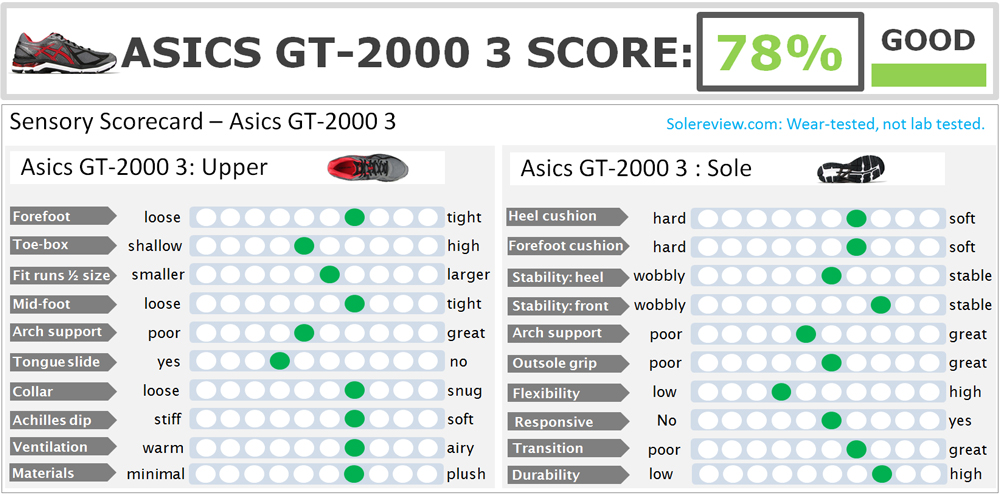
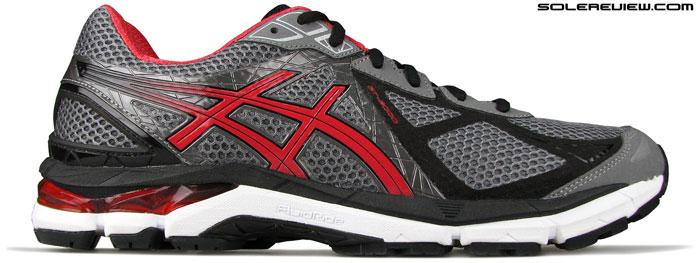
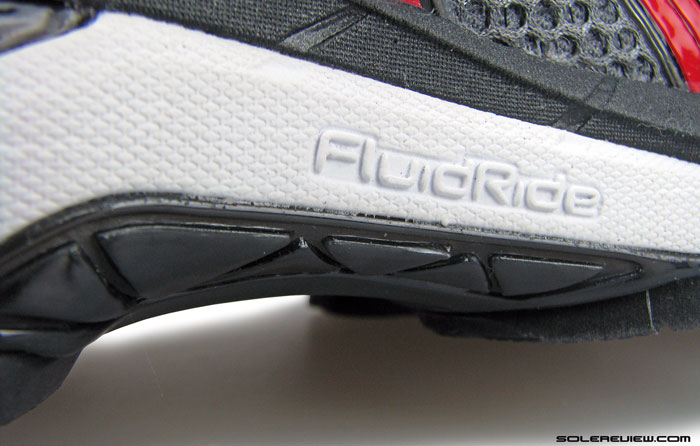
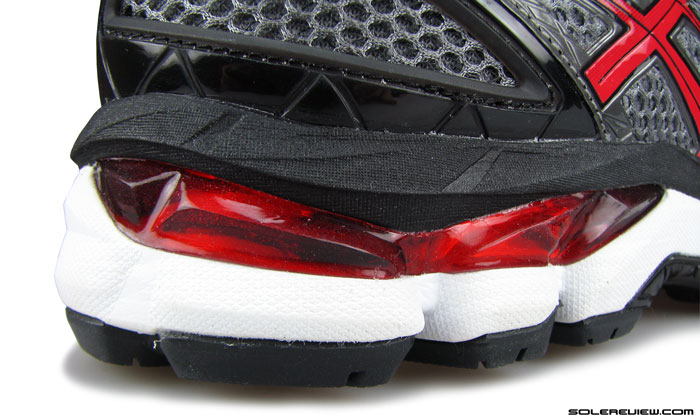
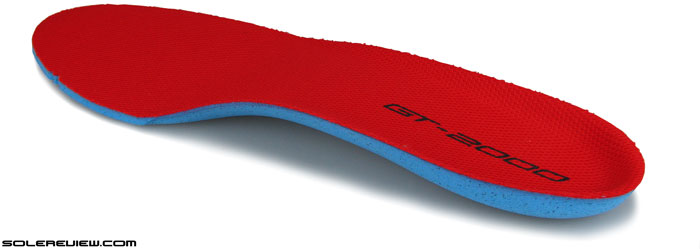
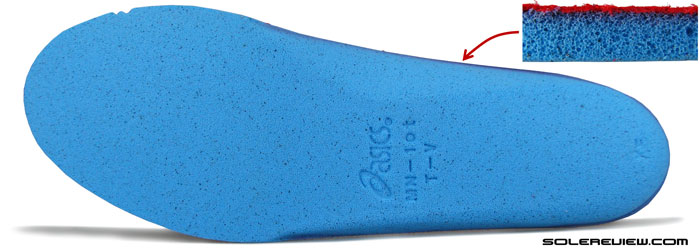
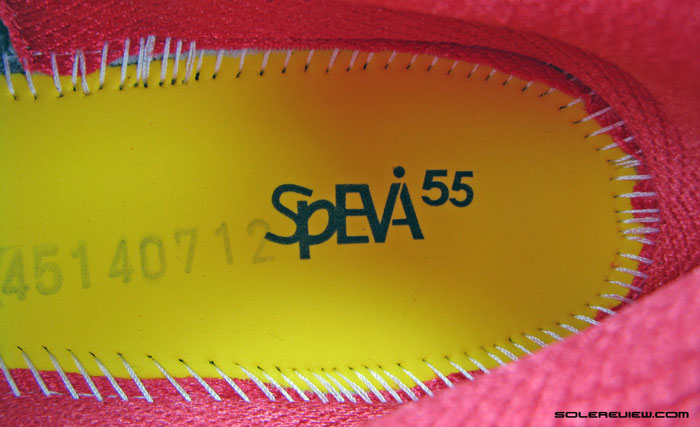
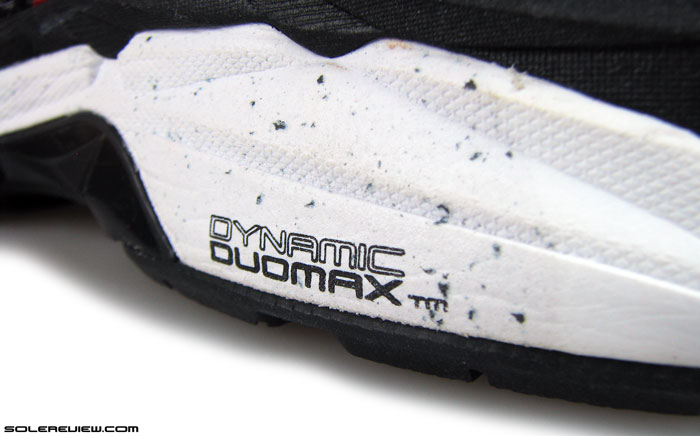
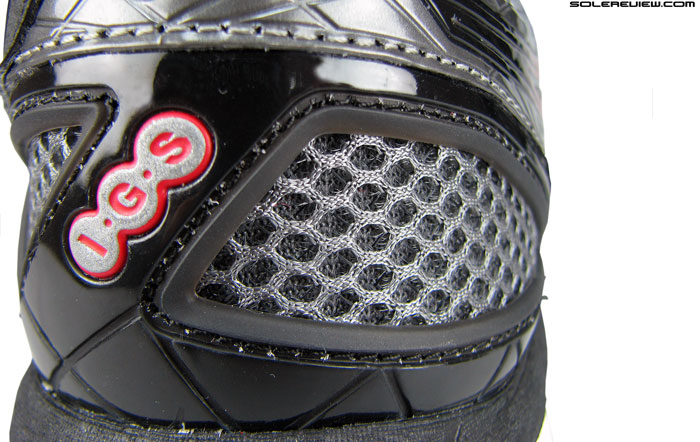
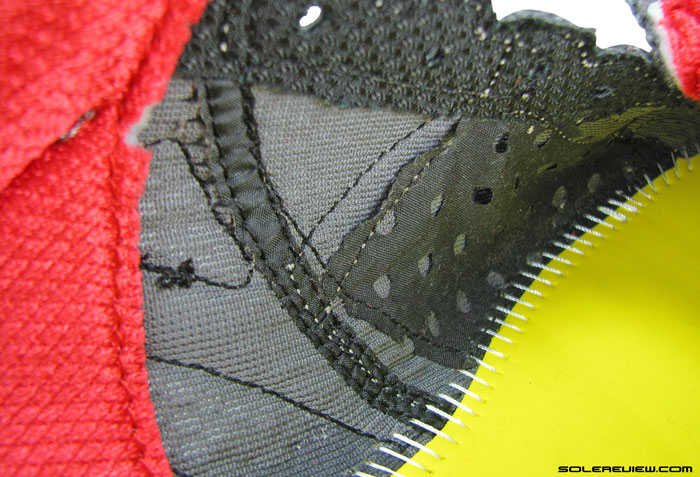
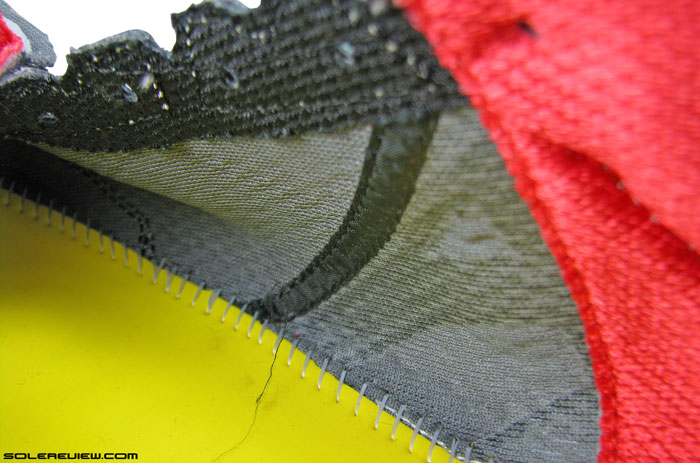
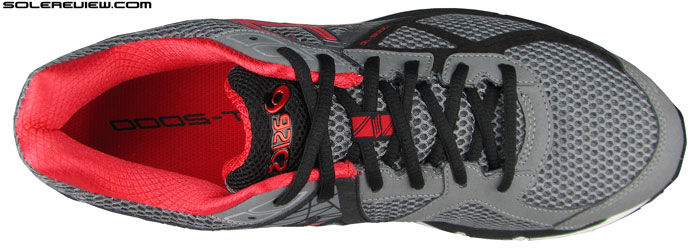
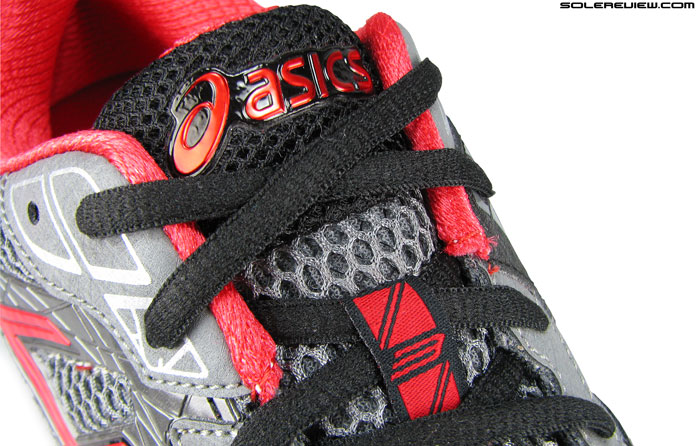
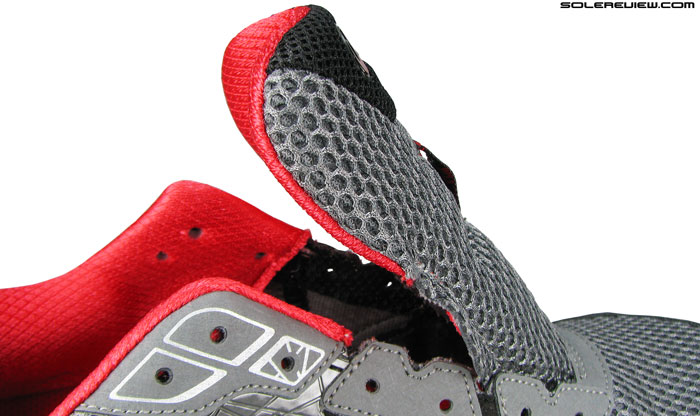
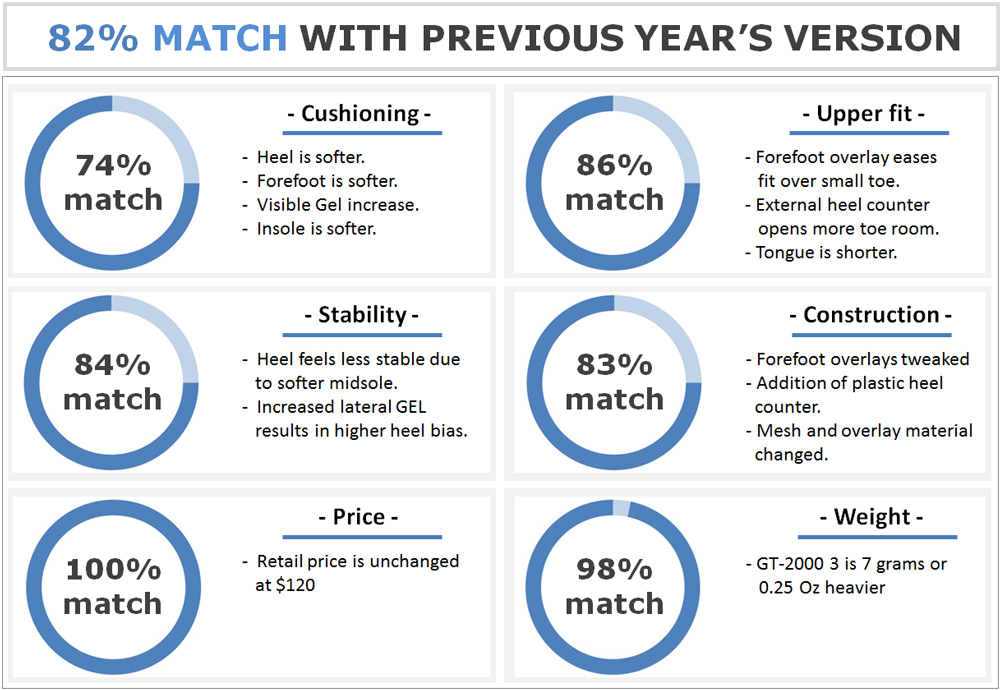
100 comments
Awesome review! I will pass these on and wait for the new 2015 natural line Asics shoes that you guys will review in February. Happy and successful New Year for all the SR team!
Hey thanks, Pedro! Wish you a very happy new year too!!
Love the changes info-graphic! Brilliant idea.
Thanks Steven!Glad you like them!
New info-graphic is great, thanks for these brilliant reviews. Merry christmas to all of you :)
Thank you Charles. Will include this wherever we have the previous version to compare! Wish you a merry Christmas and happy holidays too!
I run I the GT 2000-2’s and my only wish is that they were a bit more cushioned and responsive. I love the rigid heel cup and the stability of the crash pad.
I’ve tried on the GT 1000-3’s, Kayano 21’s and the 2000-3’s. My impression was that the Kayano’s and the 2000-3’s lost too much stability that I liked, but they were definitely more cushioned. It seems that the trend towards the heel clutch system loses inherent stability.
So, in your opinion, what would be the closest shoe in comparison to the previous GT 2000-2’s in stability but with added cushion and responsiveness?
I would love your thoughts on this. Even if it was for a previous version such as the Kayano 20 etc.. Another brand/model? That I could still pick up.
Thanks again for a great review !
Based on your frame of reference, the Kayano 20 is a strong candidate. More cushion, yet stable enough. Not much of responsiveness, though, but traditionally that is how Gel based shoes have felt.
If you’re open to experimenting, then New Balance’s 1260V4 and Adidas Supernova Sequence 7 Boost are worth a glance and fit trial.
1260V4 is more cushioned and responsive than GT-2000 2 and Kayano 20, while it feels a mite less stable. Supernova Sequence has a level of stability which in our opinion, is on par with GT-2-2 and K-20. Softness of cushioning is lower, but on the other hand, it feels more responsive during faster runs.
Among others, Saucony Guide 8 has the stability but not the cushioning. NB 860 V5 has responsive cushioning, but it has a pronounced motion control (harder medial post vs lateral midsole)
Hope this helps somehow, and we’ll be happy to take more questions on this topic.
which shoe is more plush for the neutral runner: the Kayano 21, Clifton, or Nike Pegasus?
The Clifton, Kayano 21 and Pegasus, in that order when it comes to cushioned ride. That said, the Kayano 21’s upper feels the plushest.
Hi, I really like your reviews and the amount of detail that is provided in each review. I am a heavier runner (weighing 86 kilos) and normally run around 3-4 miles, thrice a week. I have been running in the Pegasus 31 and love their soft cushioning. However, I would prefer a bit more stable and firmer ride and was thinking about the GT 2000 v3. But after reading your reviews for both GT 2000 3 and Kayano 21, it seems that the Kayano 21 can also be a good option, as I would prefer soft cushioning along with some stability. Can you please recommend a good option (kayano 21, mizuno enigma or probably the nimbus 17 once it is available). I also suffer from shin splints and can any of these make a difference. I am currently in Amsterdam and run mostly on roads.
Would still pick the GT-2000 3. The Kayano 21 is too soft based on your selection criteria.
Thanks for the quick reply. Will check these out
Thanks as always for your work on the site – always fun to read such in-depth reviews. I’m a little confused about this GT-2000 3 review though. I can’t help feel that your overall disappointment with Asics lately (as seen in your Kayano 21, Cum 16, and Nimbus 16 reviews) colored your review of this shoe, too. I just switched to the GT-2000 3 from the GT-2000 2 (which I loved), and the jury’s still out. One thing I have noticed on my first two runs in them is that there seems to be heel slip present in the V3 that wasn’t there in the V2. If I decide to move on from the GT’s, what would you recommend that’s along the lines of the V2? The Guide 8 doesn’t stop my pronation enough. Maybe the Hurricane 16 or NB 1260v4? Happy New Year!
You’re welcome, happy to hear that you’re enjoying our reviews! A happy new year to you too!
About the heel slip – we mentioned that the V3 had more open room upfront, and this might be causing the foot to move slightly forward during the gait cycle. That’s the only the reason we can think of. Perhaps thicker running socks can help.
Haven’t tested the Hurricane 16 so can’t comment on that, but the 1260v4 (and even the 860 v5) are worth a try. That said, one can never be sure till you’ve done a few weeks in them. As far as the Guide 8 is concerned, would agree with your assessment. At best, they’re a pair of neutral runners with a firm ride – our review up tomorrow.
Did you think this review to have negative undertones? We treat all shoes equally, and the occasional sarcasm drips in every review :)
Appreciate the quick response!
Ha – understood on the sarcasm. I guess I’ve just noticed it more in the Asics reviews lately as a guy who runs primarily in them? ;-)
I’m going to keep running in these V3 a while longer to see how they shake out for me. Luckily my LRS has a 30-day trial policy. The 1260’s are very tempting, as are the 860’s. I know you have the full review coming soon, but could you share a brief thought or two on the 860’s relative to these GT’s and the 1260’s?
If you want to see a negative review, read our adidas PureBoost review!
860 is essentially a lower Tier 1260. More details will come through in our review next week, but here are some initial thoughts:
a) Much more of a motion control shoe than V3 (and even perhaps the 1260 – but we need more miles to nail this impression). The harder medial post is very noticeable during runs, and so does the lateral bias. The lateral midsole has these gaps or vents between them so that the shoe can collapse with relative ease laterally.
b) Midfoot fit better than V3 and 1260 V4 due to use of midfoot strapping system
c) Great upper fit, typical NB.
d) Less cushioned than V3 and 1260.
Please understand that these are first impressions, and might evolve by the time we review the 860.
Cool. Almost seems like the 860 is closer to the GT-2000 2 than the GT-2000 3 is. Fair comparison there?
In relative terms, yes. But they still are different shoes (V2 and 860), in terms of upper materials/fit, and ride character.
Asics is living with the past goals, no news in the top range, only a bit color here, a pattern there and a Little bit more gel there.
They need to change all the range from zero.
I prefer Brooks much better.
Will agree here. They tend to follow trends, instead of trying something new.
Is Asics use of visible gel increasing the cushioning, or is it more cosmetic? When open up the midsole, you often find that it is two separate units.
They are certainly functional. Visible gel has this tendency of increasing lean where they are placed. They also don’t break down as easily as foam.
If this is the case why don’t they use more gel? Heavier, more expensive?
Yes, that seems to be the case.
Hi!
I am a supinator, and when looking for a new pair of running shoes to tackle 10k, the salesman advised this shoe. I’ve been running with it for more than a month now and I must say that I haven’t suffered any injuries like with other shoes. However, the Asics site recommends this shoe for “mild to moderate and late-gait overpronators”. The Nike site even recommends neutral shoes for supinators… I must say, I am really confused about all this (different) information! So I guess my question would be is this shoe really adapted to my pronation? Thanks a lot!!
Don’t worry about pronation and shoes. The whole thing is over-simplified, which doesn’t work that way.
The GT 2000 3 works for neutral runners too, and if they aren’t causing you any injuries, then nothing to worry about.
Running form and physical conditioning matter more than shoes!
Thanks! :)
My wife was recently fitted at a local running store. She chose the gt 2000 3 as her favorite. They were a little out of the price range we were looking to spend. I found the gt 2000 2 online for half the price. She says they don’t feel at all the same and seem to be wider than the 2000 3. I guess I have 2 questions. Is this the general consensus when it comes to the fit between the two models? And secondly if we went with the gt 1000 3 would it fit more similarly to the 2000 3 and would it have the same softer cushioning as what is talked about in the article?
1) Our opinion was that the GT 3 fit is wider in the forefoot than GT 2000 2. Yes, they do feel different, as the latest GT is softer than the 2013 version.
2) The GT 1000 3 is a firmer shoe, and does not feel the same as GT 2000 3 when it comes to cushioning. However, the GT 1000 feels a bit more relaxed in the forefoot.
If you wait up a month or so, the prices of Holiday season colorways (of GT 2000 3) should drop.
I’ve been hanging on to the past and have always work the asics GT-2170. I am starting training for a half marathon after an almost 3 year hiatus for having babies. I tend to pronate and like the stability shoes. I also seem to get the occassional shin splint and would love to get a shoe that helps with that. What would you steer me towards as a good replacement for my 2170s??
That is a tough one, replacement for the 2170. The GT 2000 3 bears some resemblance, but only in parts – for example, the cushioning is closer to 2170 than earlier GT 2000s.
You could try that, or something like the Brooks Adrenaline GTS 14 which blends stability, motion control and cushioning well.
Great review and comparison.
I’ve been running with the previous GT-2000 2 and switched to a GT-3000 2. But only to develop a heel spur kind pain since. I’ve stopped running in the mean time but I wanted to see what other shoe replacement I could look at. I’m a overpronator and was advised that perhaps the Kayanos might not be suitable for me. Which is why the recommendation for the GT-3000 2 was made. But unfortunately, it’s caused me problems since.
Would love to get your take on this. That is, to stick with the GT-2000 series and get the new version 3 or the new Kayano 21 might be a better fit for me.
Thanks!
Can’t say for sure, but if the GT 2000 2’s served you well, the GT-2000 3 feels like a safe bet.
Great review!
I’m used to run in the Asics Gel 1100 series. had the 1150 and now want to retire my 1160 for good.
As i’m a bit of an over-pronator and had Shin splints in the past (before changing to Asics shoes), I’m really cautious about picking out a good running shoe.
As I noticed the past several months, you just can’t get these shoes anymore. so I wonder – which series has replaced the 1100? and what is the closest match for the 1100 these days?
The Asics Gel Foundation 8 is a close match, followed by GT-1000 3.
Thanks for the quick response :) I’ll check them out..
Great work guys! Your passion for running shoes is evident from all the meticulous reviews you do.
I am a 185lbs 6′ male. I have been running on asics nimbus 16 for a year now. The problem is whenever I try to increase my distance, my legs get extremely stuff and fatigued. I am an overpronator,with a slightly more flat right foot. so I guess that is the reason. Should I buy stability shoes or motion control shoes? Please suggest the best shoe for me amongst Asics, Nike or Adidas, since only these are available in my country. Thanks a ton.
Thank you for the comment!
If your legs are getting fatigued over distance, we’re sure it is not because of the shoes. We’ve always maintained that shoes are just a very small part of the whole deal – what really matters is your running form, physical conditioning/strengthening, along with gradual increase of running distance.
If that part is taken care of, you can wear most shoes. That was our two cents. If you want a motion control shoe, then good options are the Asics GT 2000 3, Nike Structure 18, Lunarglide 6 and the adidas Supernova Sequence Boost 7.
Thanks so much for all the info! I’m a 5’1″ female overpronator with flat feet. I ran for a while with an older version of New Balance 860’s and after a running hiatus (due to laziness), starting running again with Asics 2000v3, but now get small blisters and knee soreness sometimes (unsure if this is due to age, sizing issues (they feel big even though store fitted me), etc). I know I need a stability shoe, but am having trouble pin pointing which one would be best.
Any thoughts would be appreciated!
Where exactly are the blisters? And as far as knee issues are concerned, they’re usually bettered by physical conditioning/strengthening, though in some cases the shoes can lead to temporary soreness.
Out of all the shoes you’ve worn in the past, which worked for you the best?
I’ve really only used the NB 860s and the Asics GT2000v3 for running, so I would say the NBs worked best – but this might be biased based on my recent knee/blister issues. The blisters show up on the inside arches of my feet. Thanks!
It is possible that the inner seam (there’s a picture in our review of how it looks) is causing blister issues on the GT 2000 – not sure why your knee hurts though.
Find the perfect running shoe has always been a matter of trial and error. You could try other stability shoes such as the Saucony Guide 8, adidas Supernova Sequence Boost and Saucony Hurricane ISO, but if the NB has worked well, why not stick to the 860?
This is such great info — thanks! I am really trying to make the right choice with running shoes that’ll be good for my feet and knees. I’m a (female) mild/moderate overpronator with flexible flat feet. I tend to naturally have a good mid-foot strike, though. I get posterior shin splints, arch pain, and runner’s knee when I run in the wrong shoes. I loved the Kayano 19’s, which never gave me any problems, but I can’t find an old pair in my size online — the changes to the 20’s and 21’s make me wonder if I should go with a GT-2000 v3 instead.
I’ve been wearing Lunarglide 6’s lately, because I found a pair for a really good price, but they’ve been hurting my feet and giving me shin splints. I have to stop my runs sometimes to rest my feet because they’re throbbing with pain across the top of my mid-foot. I wish the shoes were more flexible, but still provide me with stability in the arch. I can’t seem to feel my foot strikes at all in these shoes, unlike the old Kayano’s, making it difficult to adjust my gait. Do I sound like someone who should get GT-2000 3 or stick with the Kayano’s? Thanks for any help!!
Jessica, it does sound like the GT-2000 might do it for you. And do you include conditioning/strengthening exercises targeted at developing your lower body along with your running? That helps reduce the likelihood of soreness.
I loved the 2100 series and ran in them for years. So when the new 2000s were not well received I tried the Kayona. I got a pain on my outer left foot that pinched long after my long runs. I have been told by 2 salesmen that the amount of stability (posts) is the same in the Kayona and 2000-3 so am afraid of having the same problem with the 2000-3. I have recently tried too many other shoes of other brands trying to find a replacement unsuccessfully. And am probably going to try the 2000-3 after all since I just seem to prefer the feel of asics. Is the stability similar enough between the 2 models to experience the same issue?
The Kayano 21 and GT 2000 3 are very different, in the sense that the Kayano is much softer. The GT 2000 3 has a firmer/stabler feel to it comparatively, so why don’t you give it a try?
I’ve been using a pair of 2140s for years and love these shoes – they fit my feet perfect and are so comfortable (and I have difficult feet). Now they’re finally wearing down and in need of replacement, and of course the 2140s were discontinued a long time ago. What should I do? The logical choice seems to be either the 2000 2 or 3 series but I’m wondering how this series has changed over the years and if they might feel much different from what I’m used to. Any thoughts? Thanks.
Sorry, it’s been a long time since the 2140 – won’t be able to offer any comparative thoughts. Have you given them a fit try yet, though?
Perhaps someone else can help, a lot of solereview readers are Asics loyalists.
Hi!! Thanks for all your reviews. I have been running with a pair of GT2170s because I overpronate so I need a shoe that controls pronation. However after reading both the review for the Gt1000 3 and this last one Gt2000s I am not sure which should I buy …. as the Gt2000 3 seems to provide with less stability control….
Which one do you recommend me?? (Female, 122 pounds -55kg-, 5,15 feet -157cm-)
Thanks a lot!
If you have been in the GT 2170, then either the GT 1000 3 and 2000 3 – both will do. The difference is that the GT 2000 is softer than the GT 1000. So you want more stability, then GT 1000 3 it is.
I am an avid fan of the GT2000’s V2. I recently switch to Brooks Revnna. I have not suffered with them, but they just dont seem to have a quality feel about them. So, I decided to go back to GT2000 and see the v3. Should I stick to v2 or is the V3 a similar enough shoe?
The V3 is softer to run in, and is marginally more roomy than the V2. If you find these two attributes appealing, then yes, worth a switch. Else the GT V2 is a good shoe to stick to.
I tried them – and sent them back for a smaller size (about half a size) as they seem very large compared to the same size V2. Looked very cool though.
I have worn the 2100 series for years with absolutely no problems. Just bought a new pair of GT 2000 3 which are giving me discomfort in heel. Any way I can continue to use these without chucking away and getting something else? I already wear two pairs of sox.
Would it be possible to describe what exactly is the discomfort( location around heel, intensity, flares up after x miles, one foot or both, etc)
For the first couple of runs with alternating use of two
pairs of new GT 2000 3s there were no problems. But then, the bottom of the right
foot heel and bottom back of this heel started to be uncomfortable about 105
mins into a 110 min run over up and down trails. Since then I have had some
discomfort on all runs both on and off road although it has not worsened in
intensity. When walking after runs in normal street shoes the discomfort can be
a bit noticeable. Over recent years I have had to buy Size US13s as Size 12s
are too tight and 12 ½ s are not available here..they were once some years ago but
unfortunately not now. I wear two pairs of Smartwool sox to compensate for the
slightly bigger size and this has always been fine (perfect) for the 2170s. My
left foot is slightly longer than my right. The discomfort seems to ease a bit if
I tie the laces pretty tight but that can be a bit uncomfortable in its self! Any
suggestions?? Maybe my heels will adjust to the new shoes over time??
Really hard to say for sure without looking at the shoe, and the way you run. Based on what you’ve described, it appears to be a sizing issue.
Something like your foot sliding around the heel area – since you mentioned that tying your laces tight puts a stop to the discomfort.
Apart from the laces, another potential method is to insert a thicker insole, there’s a small chance that might help.
The best solution would be to seek a shoe which fits a bit smaller for the same US 13; for examples, most adidas shoes fit a half size smaller.
Very many thanks for response. I’ll see how I go. I did notice from some other comments that the ASICS complete redesign of the GT 1000 and GT 2000 have given other runners problems as well!
You’re very welcome. Design changes always present a problem for runners used to a particular model, no matter what the brand. That is why, when you find a certain shoe you like, cash the raincheck and stock up!
I am looking to replace my year+ old Asics (that a local running store recommended). The shoe has GT-2000 on it (I’m obviously a novice runner!); what do I replace it with? is the number after the GT-2000 (2, 3, etc) just an indication of the year of manufacture? Thanks.
Yes, that is correct. Numeric suffixes indicate succeeding versions of the same model. We would recommend the GT 2000 3, by the way.
I’ve got the original GT2000 and am looking to upgrade prior to running a half marathon. I overpronate, and reading your article and reviews I’m wondering whether the v3 will give me the support I need or whether I should go with the V2. I’d love more cushioning, but not at the expense of aggravating my knee which is what suffers as a result of the overpronation. Thanks for your help
Compared to the original GT-2000, the stability is comparable and should not pose a problem. But you need to be sure, then go for the firmer GT 2K.
See a physio for exercises to help, strapping and advice.
I have overpronation feet esp my left foot and just bought the gt 2000 3 as recommended in the store but turns out my left foot still hurts. Should I change the shoes?
If the pain continues after a few days, yes, recommend to change it. Would be advisable to go back to a shoe similar to what you were comfortable with earlier, regardless of in-store recommendation based on foot type.
What were you running in earlier?
Thanks for the amazing review! I have only used Kayano 19, 20, 21. I haven’t really noticed the difference, I do love them for running though as I overprint. Do you think switching to GT 2000 v3 is a good idea, or should I just stick with the Kayano 21?
Happy to hear that you liked our review! As far as your question is concerned, if the Kayano 21 is working for you just fine, no point in changing. Better to stick to the K-21.
Which model do you think is the one that reminds the most of the original GT2000 – GT2000 2 or GT2000 3? I’ve used the GT2000 for many years now and I really like them. I have almost no over pronation at all and run at a fairly good speed (latest halfmarathon 1:27 and latest marathon 3:03), I am very light (60kg) and is in desperate search for new shoes (as my latest GT2000 are falling to pieces and it’s hard to find a new pair of that old model). From my own conclusions after reading your reviews the GT2000 2 seems to be more like the original GT200 than this new GT2000 3. Am I right?
Hi Gustav, we actually think the GT-2000 3 to be closer to the GT-2000 than the 2. We don’t have a pair lying around, so this is based on what we remember of the 2012 model.
Thanks for the reply! I’m going to try out a pair of GT-2000 3, before I make an order. I read that the sizes might differ a bit between the models, so it feels like I should try them first.
You’re welcome! Let us know how it goes for you.
I want to get a new shoe to start my marathon training. I used Brooks Adrenaline for my first marathon 2 years ago and it worked well. What Asics style would be similar to that. I’m an overpronator on both feet and have knee problems so I really need to find good stability shoes. Thanks.
Since our Asics review experience is only limited to the Nimbus/Kayano/GT/33 series, we won’t have a well informed answer. Out of what’ve tested, the GT-2000 3 comes closest to the Adrenaline – but they feel very different.
You mention that the Asics GT-2000 3 comes in size B-narrow. Narrow Asics shoes are usually labelled AA. I have a very narrow foot. Is the GT-2000 3 B as narrow as the GT-2000 2 (or GT-2000 or GT-21xx) AA? Thanks. -Marie
Hello Marie,
We were referring to a Men’s narrow, which happens to be B (the standard is D). Women’s feet are narrower, so the standard is B, and hence narrow becomes 2A. So to answer your question, a B narrow does not equal womens 2A.
This is how it goes, in ascending order: (super narrow) 3A-2A,A,B,C,D,2E,4E (extra wide)
I am toggling between buying the GT-2000 3 and the Kayano 21 as a second pair of running shoes to complement my GT-1000 3 (regular width). I have been reading that the Kayano 21 seems to fit a bit narrow because of the extra ‘plushness’; should I pick up a 2E instead of the regular M? The dealers in the city where I live don’t have 2Es to try on, unfortunately. Also, I have seen a great deal on the GT 2000-3 Trail online. I am planning to run a few trail marathons (95% of my runs are on asphalt/cement surfaces); could the GT Trails function as my second pair?
By the way, i trawl the internet for information before I buy ANYTHING: period AND your site does such detailed reviews, it is mind blowing. Fantastic is the only word that can be used! Thank you!
Hello Rajesh,
You should be ok with a regular width Kayano 21 if you’re transitioning from the GT 1000 3. And your question about buying the GT-2000 3 trail version – what kind of trails are you running on?
We haven’t tested the Trail GT2k, but from the looks of it, the shoe just seem to feature a different outsole texture and upper material package. That shoe should be ok for road and flat-trails (chip/gravel/packed dirt).
Thanks for the info. Is the Noosa Tri 9 also similar in nature to the GTs and the Kayanos?
Not sure. We haven’t tested the Noosa yet.
Cheers. Thanks. Picked up the GT trail for a decent price.
Hi, I have a very narrow foot and have been running in the GT 2100 series for the past eight years.I did not like the original GT 2000 but loved the GT 2000 v2 (B width)but when I switched to GT2000 v3 I found the forefoot too broad and my foot sort of rolled everywhere in them.I found the narrow width also too roomy.However I kept running in them and soon developed heel pain and beginnings of plantar facisitis.Which other shoes could I look into which are similar to Asics GT 2000 v 2 and suitable for very slim foot and heel?
You should look at the Brooks Adrenaline GTS 15 and Ravenna 6 – both of them have a narrow forefoot, and shares some of the GT 2000 3’s motion control behavior.
I have the same issues as morningrunner65. Narrow foot and needing stability. I have been a regular GT 2100 and GT 2000 user but the 2000v3 caused an awful case of PF after 2 wearings 10 months ago. I’m still not running even with PT. Some feedback on your suggestions….the current Ravenna is too wide for a true women’s AA foot (although I did use them for a bit 4 years ago, the current version is much too wide). For me the Adrenaline had too much support when I tried it 5 years ago. That caused knee issues for me and I’ve been hesitant about going back. I really don’t know what to do next. The Saucony Guide comes in AA, but it has a lower drop (8mm) which was giving me some peroneal pain.
In that case, the adidas Sequence 7 Boost is worth a fitting session.
The Brooks Beast 14 also fits very narrow, and assume that it is same for Women’s version, the Brooks Ariel 14. But that shoe has a lot more support than the Adrenaline, and possibly might not work for you. But you never know – given the narrow set of choices, perhaps you could try those as well.
Hi there,
Great site! I wish I had found it earlier during my hunt for new shoes!
I’ve been running in GT2000 (first gen) for a couple of years, and decided to upgrade. While I was only semi-happy with them, they were ok for my needs. (The last pair of shoes I ran in that I truly loved were Mizuno Inspire 2s – I tried a pair of the Inspire 11s, but they were not great for me).
I was on a trip to NYC from Toronto recently and saw the new GT2000 3 for a better price than I could get it up here, and after a little run in the shop on the treadmill, decided to pick them up.
I haven’t gone for a proper run yet, but noticed something in the interior that is a little concerning, potentially, and thought I would see if anyone else noticed, or if it is just my particular pair. I didn’t know if it might be a defect or just the design.
On each shoe, on the inside, behind the plastic (?) medial lay stretching from the laces and connecting to the other plastic strip is a flap of loose cotton like material. Sorry for the poor description.Anyway, this white flap of material just kind of hangs there – I’m a little worried about it bunching or chaffing on a long run. My old gt2000 were perfectly smooth on the inside, so I don’t know why this is here. It looks like it could have been lining the back side of the
plastic strip but came unglued maybe? They were in the trunk of my car for a day in the very hot sun, so maybe came loose, but both, exactly the same?
Part of the problem is I can’t take them back to the States – I suppose I should have bought them here, but saw a great deal and jumped on it, so too late now.
Has anyone else noticed this little flap on the inside of this shoe? Did it cause any issues? I’m thinking of either trying to glue it down, or snip it out, but don’t want to make matters worse. Other than that, I’m impressed by the shoe.
Here is a photo of what i’m talking about – I’ve circled the flap. Thanks for your patience with this long post.
Thank you for the picture, and this component is indeed strange. You know how the insides of our GT 2000 3 pair looks like (pictures in our review), they do not have this flappy piece.
Our advice is to let it be. If it is not causing any issues, then don’t take any preventive action. Like you said, it can make things worse.
Hi,
I’m a recreational runner and I’ve done a marathon and over dozen half marathons so far. I needed new running shoes and opted for the GT-2000 3. After the first run (about 6km) I felt a slight pain in the outside of my left foot, but attributed it to the the shoes being brand new. I ran few more times and the pain intensified to the point I had to stop running for 2 weeks. I returned the shoes and got Nike Free 5.0 instead and I’ve been running smooth ever since. I remember someone in this forum had the same issue. I’m not saying the GT-2000 3 is a bad shoe, but I recommend everyone trying them for a week before committing to purchase.
Cheers
Appreciate the feedback. This is proof that running shoes work in so many different ways depending on the runner.
I am a new runner and run approx 4 kms. But not more. Plan on 1/2 marathon bu december
Weigh approx 148 lbs. I have been told for this model due to a slight pronation.
Can you suggest me similar shoes in brooks as well as saucony ??
In Brooks, it would be the Ravenna 6/Brooks Adrenaline GTS 15. For Saucony, look at the Guide 8. Here are our reviews:
https://www.solereview.com/brooks-ravenna-6-review/
https://www.solereview.com/brooks-adrenaline-gts-15-review/
https://www.solereview.com/saucony-guide-8-review/
I am looking for a shoe that runs similar to the old glycerin 11. I recently purchased the nimbus 17s and they turned out to be very mushy like in your review. So I read through older reviews and am debating between the asics Kayano 20 or nimbus 16. Which has the firmer yet cushioned forefoot? Or would the GT2000-3 fit closer to that profile? It is a struggle finding a firm cushioned shoe in a size 16 that I can put miles in with out putting too much pressure on the 3rd and 4th metatarcels like the numbus 17 showed me after 2 miles. Thanks for the help, always love the reviews!
The GT 2000 3 and Nimbus 16 are closer to how the Glycerin 11 felt, but only relatively so.
Would also suggest the UnderArmour Speedform Gemini. Very different upper vs. the G-11, but there might be something in its ride you might like.
Have to thank idiots at Asics once again for taking away the GT 2160 (and beyond…) series. The greatest all around most cushioned comfortable running shoe know to man. Why Asics? Why? Are you cheaping out by putting less cushion in and charging more? Are you just trying to capitalize on “new”? Spent a ridiculous amount on Gel Nimbus 16 and they’re NO WHERE near the GT-2160s. Can anyone out there suggest a near perfect replacement to the GT-2160 specifically in the arch cushion?
The 2160 was a great shoe. Not sure what’s the best replacement for that, but the Kayano 21 is worth a try.
And though it might sound unconventional, the 2014 Brooks Transcend (not the 2) is an option too, as it has a lot of under-arch cushioning/support.
I’ve been running in the GT 2000 V2’s for the last year and really appreciate the stability of the internal heel counter and medial post. I tried on the V3’s and you are spot on about the loss of stability.
So, now that my V2’s are getting old and scarce to find, what would be the closest replacement in your opinion?
The V2’s really grab your heel and don’t slide up and down which I like. Only flaw is the little toe top pressure. Maybe a little more forefoot cushioning would be good.
Not a fan of the new heel clutch system.
Any other models out there that fit like the. V2 and are stable ?
Thanks in advance !
The Brooks Adrenaline GTS 15, and Saucony Guide 8 come to mind. (haven’t tried the GTS 16 and Guide 9 yet). If you don’t mind the lack of a medial post, but can make do with a cushioned midsole and good heel grip, the Nike LunarGlide 7 is worth a shot too.
This is a little off topic but looking for a review on the Asics GT 2000 3 (trail) shoe. Couldn’t find any trail running reviews – could you lead me to one?
I have been happily road running with women’s gel Nimbus 15 after a few set backs looking to replace the Asics 2100 series. Then I developed PF. Despite the rigours of trail running I found it eased all the discomforts (shin/foot issues) of pavement/flat surface running.
I went from the Asics 2100 to GT 1000, Adidas Adistar Boost, to finally the Gel Nimbus 15 to find the right fit, but it’s not quite stable enough for trail running.
thanks!
Shirley, we don’t do trail, but you can search websites such as irunfar.com, roadtrailrun.com, runningshoesguru.com and runblogger.com. They have trail running shoe reviews, though not sure whether you’ll find the exact model.
Comments are closed.